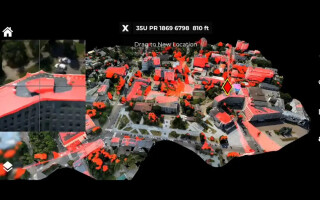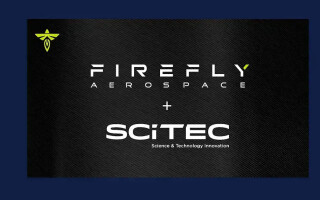Intel's CPU extensions transform virtualization
StoryJanuary 27, 2009
Virtualization is a key technology in today's commercial and military technology industries, but it has historically presented developers with difficulties in information assurance based systems. However, Intel's VT-x and VT-d hardware extensions are breathing new life into the virtualization process and show promise to become the de facto methods for implementing virtualization.
Virtualization is a
technology we have all recently come to understand on our desktop systems. Many
of us today host multiple operating systems on the same computer using
commercially available software. Virtualization is the method by which programs
– including operating systems – can run in a software environment as
though they were running on native hardware. This environment is called a Virtual Machine Monitor (VMM), also
referred to as a hypervisor. Figure 1
shows a notional architecture of a VMM environment. The VMM layer is hosting a
guest operating system.
Figure 1
In the military embedded space, applications have typically
been hosted on physically separate machines to enforce safety or security
requirements. With recent developments in processor architecture, it is now
possible to migrate such applications onto a single machine and provide
software separation using hypervisors and separation kernels. This is important
to the defense industry as it facilitates legacy code hosting on the same
platform as newly developed architectures, reducing hardware footprint and
achieving software certification for safety and security.
For commercial or military applications, hardware support
provided by Intel's VT-x and VT-d CPU extensions simplifies processor
virtualization, enabling reductions in VMM software size and complexity. This
results in VMMs that can support a wider range of
legacy operating systems while maintaining high performance and efficiency (www.intel.com).
In the following sections, we will examine some of the technical
difficulties developers have discovered while bringing virtualization into
information assurance based systems. We will also discuss how Intel's hardware
extensions are helping to overcome such issues.
Intel virtualization extensions: VT-x and VT-d
The advances being made today by CPU makers and hypervisor
developers are helping to define the way for future virtualization platforms.
New CPU extensions are not only helping to meet the high-performance
requirements of future systems, but they're also making it easier to implement
and support legacy operating systems.
In years to come, implementations such as VT-x and VT-d will
play an increasingly important role in virtualized systems as industry adopts
these types of implementations as effective hardware assistance standards for
future CPU architectures.
Meanwhile, hardware and software vendors are working together
to make current hypervisor designs simpler and more efficient. Intel VT-x and
VT-d technology leads the curve in this area for x86 architectures. Intel was
the first hardware provider to offer virtualization assistance at the hardware
level and is already in its second generation of this technology. Initial
performance tests show that this technology is enabling fully virtualized
operating systems to compare with para-virtualized
versions, reducing the need for operating system modification. Para-virtualized
operating systems, by definition, require a level of porting from their native
versions to support the hypervisor environment. LynxSecure's
embedded hypervisor from LynuxWorks takes full
advantage of these hardware extensions and provides full virtualization for its
future guest operating systems.
Emergence of virtualization techniques
Operating systems for Intel architectures are written to run
directly on the native hardware, so they naturally assume they fully own the
computer's resources: The x86 architecture offers levels of privilege, and
operating system code expects to run at the highest privilege level. This is
fine when run as a native OS, but when virtualizing
the x86 architecture, the guest OS runs at a lower-level privilege than the
underlying VMM. This is necessary, as the VMM must be able to manage shared
resources. There are also differing instruction semantics when instructions are
run at a different privilege level compared to that of the native
implementation. The difficulty in trapping these types of instructions and
privilege instruction requests at runtime was the challenge that originally
made the x86 architecture so difficult to virtualize.
Then in 1998, VMware developed the binary translation method.
Since the adoption of binary translation, competing
hypervisor companies have differentiated their wares by employing a range of
techniques to address the same problem, each trying to leverage their solution
in the marketplace. The problem with that is because there are no industry
standards for VMMs, we now have three different options to choose from for
handling sensitive and privileged instructions:
n Binary
translation
n OS-assisted
(also referred to as para-virtualization)
n Hardware-assisted
or full virtualization
Binary translation
The binary translation technique was and still is the de facto method by virtue of the number
of VMware copies around the world. Its principle is to translate the nonvirtualizable privileged instructions with new sequences
at runtime while user instructions execute directly on the native hardware.
This combination provides full virtualization as the guest operating system is
decoupled from the underlying hardware by the VMM. This method requires no
hardware assist or operating system assist. The main advantage of this approach
was that it allowed virtualization to become possible on x86 platforms,
something thought impossible prior to this technique. The main disadvantage to
this approach is that it requires OS modification at runtime, which reduces performance
compared to hardware-assist techniques.
Para-virtualization
Para-virtualization is the technique whereby the VMM and
guest operating systems communicate by use of hypercalls.
In this situation, nonvirtualizable privileged
instructions are removed and replaced with hypercalls.
These hypercall interfaces also handle other critical
kernel operations such as interrupt handling and memory management.
Para-virtualization differs from binary translation and full virtualization in
that it requires modification of the guest operating system. It should be noted
that in most cases, para-virtualization offers the
best performance of the three virtualization options.
Hardware-assisted virtualization
In contrast, hardware-assisted virtualization, such as Intel
VT-x technology, has the advantage over traditional software techniques because
Intel controls the CPU. By introducing a new CPU execution mode feature that
allows the hypervisor to run in a root mode below the normal privilege levels,
the previously described issues relating to privileged instructions are
overcome. Early releases of this technology, however, were slow, making para-virtualized techniques seem more beneficial. However,
we are now seeing hardware-assisted performance quickly approach near-native
levels.
Memory management and device I/O is a key area where
hardware-assisted techniques are helping hypervisor developers. Native
operating systems expect to see all of the system's memory. To run multiple
guest operating systems on a single system, another level of memory
virtualization is required. This can be thought of as virtualizing
the Memory Management Unit (MMU) to support the guest OS. The guest OS
continues to control memory mapping within its OS but cannot see the full
machine memory. It is the responsibility of the VMM to map guest physical
memory to actual machine memory. When the guest OS changes
its virtual memory mapping, the VMM updates the shadow pages to enable direct
lookup. The disadvantage to MMU virtualization is that it creates some
overhead for all virtualization techniques, which can cause a hit in
performance. It is this area where Intel's VT-x technology is providing efficiency
gains.
Intel VT-d steps in
Device and I/O virtualization is the final component required
to allow full virtualization to take place using hardware assist alone. This
involves managing and routing I/O requests between virtual devices and the shared
physical hardware. In para-virtualized systems, this
translation is peformed in software but with a
significant overhead. The latest advances using Intel's VT-d technology for
directed I/O solves these issues and has become a standard for x86 virtualization.
Intel VT-d enables system software to create multiple Direct
Memory Access (DMA) protection domains. Each protection domain is an isolated
environment containing a subset of the host physical memory. Depending on the
software usage model, a DMA protection domain might represent memory allocated
to a Virtual Machine (VM) or the DMA memory allocated by a guest-OS driver
running in a VM or as part of the VMM itself. The VT-d
architecture enables system software to assign one or more I/O devices to a protection
domain. DMA isolation is achieved by restricting access to a protection domain's
physical memory from I/O devices not assigned to it. This occurs by using
address-translation tables, thereby providing the necessary isolation to assure
separation between each virtual machine's computer resources.
When any given I/O device tries to gain access to a certain
memory location, DMA remapping hardware looks up the address-translation tables
for access permission of that device to that specific protection domain. If the
device tries to access what is outside of the range it is permitted to access,
the DMA remapping hardware blocks the access and reports a fault to the system
software (Figure 2).
Figure 2
(Click graphic to zoom by 1.9x)
As alluded to previously, virtualization allows for the
creation of multiple virtual machines on a single server. This consolidation
maximizes hardware utilization, but applications require a significant amount
of I/O performance. Software-based I/O virtualization methods use emulation of
the I/O devices. With this emulation layer the VMM provides a consistent view
of a hardware device to the VMs, and the device can
be shared among many VMs. However, it could also slow
down the I/O performance of high I/O performance devices. In contrast, VT-d can
address loss of native performance or of native capability of a virtualized I/O
device by directly assigning the device to a VM.
In this model, the VMM restricts itself to a controlling
function for enabling direct assignment of devices to its partitions. Rather
than invoking the VMM for all (or most) I/O requests from a partition, the VMM
is invoked only when guest software accesses protected resources (such as I/O
configuration accesses, interrupt management, and so on) that impact system
functionality and isolation.
To support direct VM assignment of I/O devices, a VMM must
enforce isolation of DMA requests. I/O devices can be assigned to domains, and
the DMA remapping hardware can be used to restrict DMA from an I/O device to
the physical memory presently owned by its domain.
Virtualization's "crystal ball"
Over time, as hardware
virtualization CPU extensions such as Intel's VT-x and VT-d evolve, we should
expect to see the focus on software
virtualization techniques diminish. As hardware-assisted features mature and
become less vendor specific, traditional hypervisors will become more of a
commodity utilizing a standard set of features while still competing on
performance and functionality. Features such as software separation,
particularly in the military and aerospace market, will be important
differentiators. Leading the field in these areas are companies such as LynuxWorks with its secure MILS separation kernel, LynxSecure. This technology affords software separation as
well as traditional hypervisor functionality, providing a platform for emerging
security standards and protection profiles.
Stuart Fisher is
a product manager for LynxSecure at LynuxWorks, Inc. He has more than 15 years of experience in
the embedded market, both in engineering roles and customer interfacing
positions. Stuart is based in Sutton Coldfield,
England, and is a graduate of the University of Coventry, where he earned a
bachelor of engineering degree in Computing and Electronics. He can be
contacted at sfisher@lnxw.com.
LynuxWorks, Inc.
408-979-3900
www.lynuxworks.com








